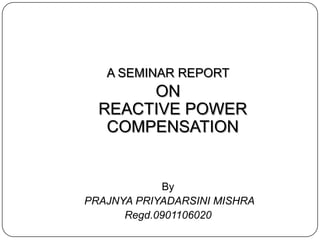
Reactive power compensation
- 1. A SEMINAR REPORT ON REACTIVE POWER COMPENSATION By PRAJNYA PRIYADARSINI MISHRA Regd.0901106020
- 2. REACTIVE POWER COMPENSATION INTROUDUCTION . Major industrial loads ,for example, transformers, furnaces, induction motors etc need reactive power for sustaining magnetic field.
- 3. DEFINATION Any device which is connected in series or parallel with load and which is capable of supplying reactive power demanded by load is called reactive power compensation device.
- 4. Power factor Power factor is the cosine of angle determined by the inverse tangent ratio of reactive power and real power. The closer this angle is zero ,the lesser is the requirement of reactive power. Power factor below 0.85 is regarded as low power factor
- 5. REAL, REACTIVE, AND APPARENT POWERS Reactive power is not delivered as effective mechanical power output unlike real power which is effectively converted as mechanical power output. The portion of power averaged over a complete AC waveform, is the real power; that is, energy that can be used to do work (for example overcome friction in a motor, or heat an element). On the other hand, the portion of power flow that is temporarily stored in the form of magnetic or electric fields, due to inductive and capacitive network elements, and then returned to source, is known as reactive power.
- 6. The figure shows the relationship between the reactive power,active power, and apparent power on a power factor angle . The load is uncompensated.If the conductor is fully loaded,the arc of the circle represents the maximum power output. The less the power factor angle of the circuit, higher the apparent power,higher the losses,for the same amount of real power. CosQ=p/s SinQ=Q/S Uncompensated Load S Q Q P
- 7. Compensated load Qc=P (tanQ-tanQ1) Qc S Q S1 Q p
- 8. THERE ARE TWO MAJOR WAYS OF REACTIVE COMPENSATION Shunt compensation: Shunt capacitors are connected in parallel in the system and are used mainly for power factor improvement and in harmonic filters. It also boosts the voltage of the bus. This also known as load compensation.
- 9. SHUNT COMPENSATION V-1 X R V2 source Load Vr JX P V2 Q Q R
- 10. Shunt compensation with current source Source V V2 X R Load Z Q V JX P $ V2 R P Q Q
- 11. Series compensation Series capacitor are connected in series in the lines and are used mainly for boosting the receiving end voltage, increase in transmission capacity and reduction in losses in the lines. It also improve power factor at the sending end of the line. Unlike shunt capacitor whose output depends on the voltage, the voltage improvement by series capacitors increase with increase in load current. In other word the series capacitor is a self regulating type. Series compensation is also known as live compensation.
- 12. SERIES COMPENSATION Source V1 V2 X R Load v JX V2 Ip Ic R Q
- 13. SERIES COMPENSATION WITH VOLTAGE SOURCE sourc v1 R V2 V2’ X load e Vcomp V2’ Vcomp v1 JX v2 R If
- 14. FIXED COMPENSATION VS DYNAMIC COMPENSATION FIXED COMPENSATION:-Here the reactive power fed by the capacitors to the system is fixed. These are basically breaker controlled capacitors and are used in system which has constant load having a set pattern of operation. DYNAMIC COMPENSATION:-Here the reactive power fed by the capacitors to the system is dynamic. This is done using thyristor controlled capacitors. These are used in systems where the loads are fluctuating in nature like arc furnace loads.
- 15. BENEFITS OF REACTIVE POWER COMPENSATION Better efficiency of power generation, transmission and distribution Improvement in voltage Reduced KVA demand Higher load capability. Reduced system losses.
- 16. Conclusion why capacitors are used as reactive power compensation device? A capacitor is said to be generator of reactive power. When a capacitor is connected across a load, it provides reactive power to the load. Dielectric materials make it possible to increase the output per unit and to reduce losses, thus making the compensation by means of capacitor more profitable.
- 17. Thanks
